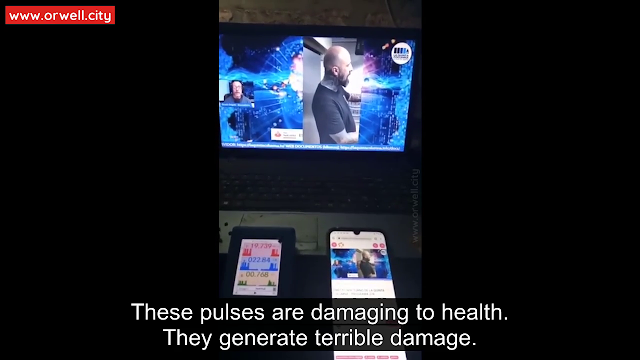Graphene Quantum Dots can penetrate the cell barrier and cleave DNA
December 06, 2021In support of the research being carried out by La Quinta Columna, Dr. Pablo Campra, and researchers working anonymously, J.L. Camacho's Mundo Desconocido channel has released a video summarizing in a very easy-to-understand way how graphene oxide manages to penetrate cellular barriers and nick DNA. This system would be part of a larger one that, in the end, would allow, together with other elements, the generation of MAC addresses and changes in the human genome.
Orwell City brings the video to English.
J.L. (Mundo Desconocido): Identification of patterns in the blood of vaccinated persons: graphene quantum dots. The so-called GQDs.
OK. Take a look at the following images. In them, you can carefully observe some red blood cells, erythrocytes, blue in color with a ring shape. But in addition to these red blood cells, red cells are in the shape of a ring, there are other elements are not clearly identified. They're or are shaped like luminescent dots, and they're variable in size. After considering these images and contrasting their morphology, we have come to the collection or conclusion that they are graphene oxide quantum dots, also called GQDs (Graphene Quantum Dots) or GOQDs (Graphene Oxide Quantum Dots).
Why do we say that?
The first shred of evidence is found in this work we're showing you. It was carried out in 2011. And in it, you can see how the molecules are transformed (C60 carbon molecules) into something known as fullerene. In what can be called graphene quantum dots. The fullerene is a spherical molecule of graphene. A structure of 20 hexagons and 12 pentagons. But let us continue with these works. The microscopic characterization was carried out with the STM (scanning tunneling microscope). In the investigations of this work in 2011, we found graphic evidence that when we decompose the C60 fullerene into graphene quantum dots with a hexagonal shape. A very concrete image is formed in which we can see that the patterns observed in the blood show an almost exact coincidence with the one we have been able to see in the sample image.
So, the scientific literature shows us that what we're seeing there are indeed graphene quantum dots. Because these quantum dots have small dimensions, a few nanometers, and have a kind of retention on the luminescent properties, they can be clearly identified. As can be seen here in the image marked with red circles. The existing similarity is undeniable. Even the TimTruth documentary in 2021, in which a series of researchers consisting of Axel Bolland, Bärbel Ghitalla, Holger Fischer, and Elmar Becker, presented themselves in the documentary and showed a spirotronic device they called "swimmer." And in those images, you could clearly identify those graphene quantum dots. You can clearly see how they appear in this image.
To all this, we must add another fundamental evidence. It can be seen how these graphene quantum dots conduct a penetration into the blood cells. The evidence can be found in the following image. Let's say that, in this image, we can see in point A and point B. And how in A, the graphene quantum dot tries to access the interior of a cell. And at point B, it has already managed to access the inside of the cell. Even in the following image, you can see how, again, that quantum dot penetrates inside the cell, closely followed by several quantum dots of different sizes. The problem is bigger because, even in the image we are showing you right now, all the phases of the process can be observed. In addition to the fact that more than one graphene quantum dot can enter the cells. As you can see here.
In box C of this figure, you can see how even up to five graphene dots have penetrated inside a cell. This ability to invade cells is well documented in the scientific literature.
Here's a research paper that was specifically done in 2015 that demonstrates that its application in traceable drug delivery for targeted, acid-sensitive delivery of a chemotherapeutic drug into cancer cells. In their work, graphene quantum dots are loaded with doxorubicin for release into cells. This is perfectly reflected in the schematic in Figure 9 of their research, as can be seen here.
Further evidence is the capabilities of graphene quantum dots to invade and penetrate cells, as well as interfere with DNA. It can be seen with the images are shown here, how synthesizing graphene oxide or graphene oxide quantum dots through the photo-fenton method, convert approximately 90% of supercoiled DNA into nicked DNA, a nick being a discontinuity between the DNA helix. Therefore, we can think that these graphene quantum dots have a much higher cutting capacity than graphene oxide sheets.
Other evidence that undoubtedly demonstrates the ability of graphene quantum dots to overcome the cell wall is found in the studies carried out specifically in 2013, 2021, and 2015, which we indicate here. In fact, nanomaterials can enter cells and affect cell division, proliferation, apoptosis, and more. It was also found that graphene quantum dots of less than 5 nanometers could directly enter cells and produce toxic effects, specifically in E. coli and Bacillus substilis cells. This demonstrates the danger of graphene quantum dots, given their ability to induce cytotoxicity, inflammation, and genotoxic effects, as demonstrated in the figure you're looking at now.
The effects of the cuts produced by graphene quantum dots can be seen in the figure you're looking here. Here it can be seen more concretely. The view on the left shows a graphene quantum dot penetration and its presence inside the cell membrane. The pictures on the right show the damage produced. The opinions that we can generate in this regard are the following: By the images observed and the existing scientific literature, the existence of graphene quantum dots in the blood of vaccinated persons can be confirmed. The morphology, structure, and special characteristics, such as fluorescence, coincide with the characterization referred to in the publications in the field.
Another opinion I can argue in this regard is that graphene quantum dots can be obtained in the microwave cleavage of graphene and of C60 fullerenes, which would explain the multiplication of these elements in the blood and fluids of the human body. This poses a serious health hazard, given their cutting potential and ability to penetrate cell walls and cleave DNA.
One more point I'd like to add is that from a functional point of view, the semiconducting properties of graphene quantum dots enable them to form a wireless network through which they can monitor and even more effectively neuromodulate as nanotransducers than graphene oxide sheets. People's behavioral patterns. Images that have transcended from blood tests of vaccinated people demonstrate the presence of fractal materials of crystallized graphene, hydrogel ribbon swimmers, and graphene oxide.
And finally, graphene quantum dots. According to all the evidence and facts noticed, it can be stated that this graphene ecosystem in the human body is designed for the reception of electromagnetic signals through graphene fractal nano-antennas and their propagation through graphene quantum dots with a double purpose. On the one hand, the possible administration of drugs and their release in biological targets. That is, in certain organs of the body. And on the other hand, the modulator purpose of neurons and other tissues of the human body that could be telecontrolled by microwaves or 5G emissions.
Finally, hydrogel ribbon-shaped swimmers have a recognized motor function that operates as a function of electromagnetic waves, so it can be equally driven by electromagnetic fields and release its pharmacological or pharmacogenetic charge."
If you like my articles and the videos you find here and, if you can and feel like it, you can make a small donation. Your support is always more than appreciated.
Follow Orwell City on Telegram. Thank you for reading!
—Orwellito.































0 comments